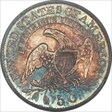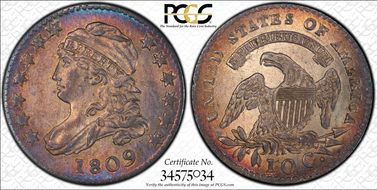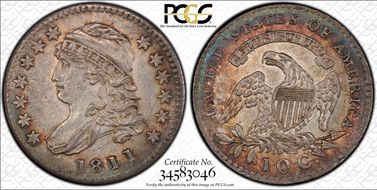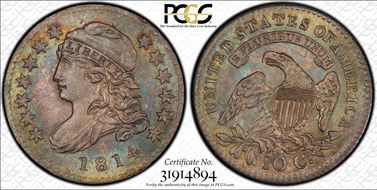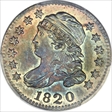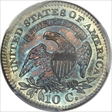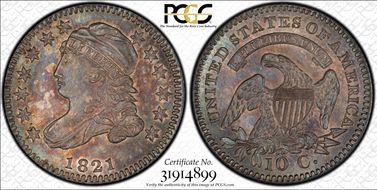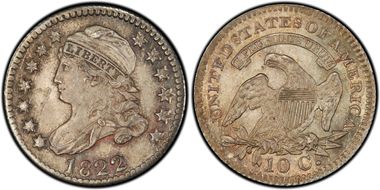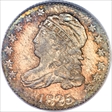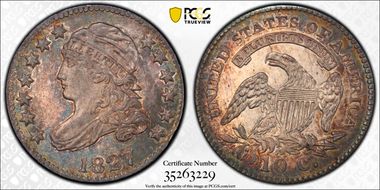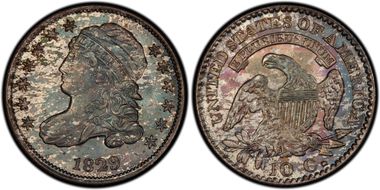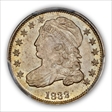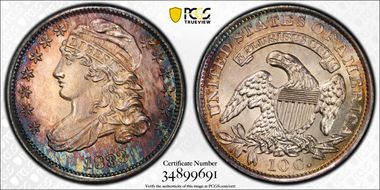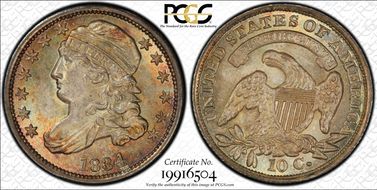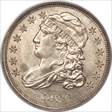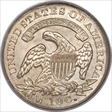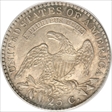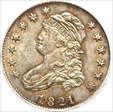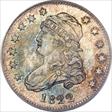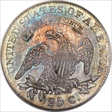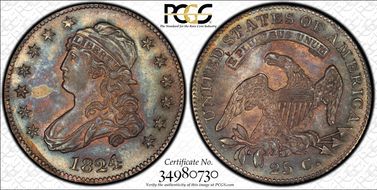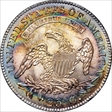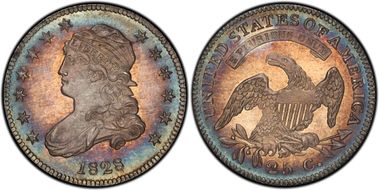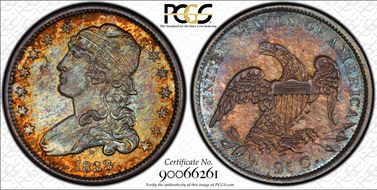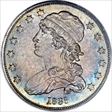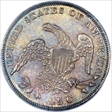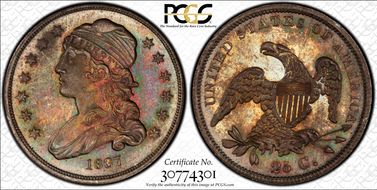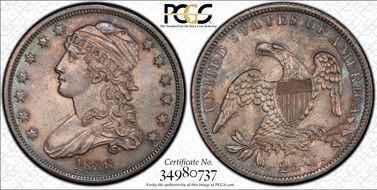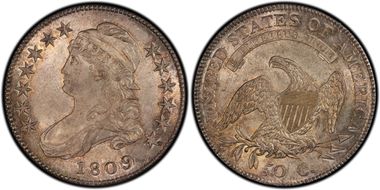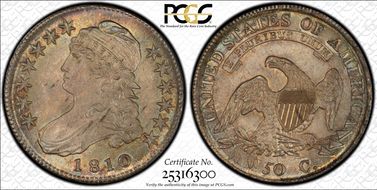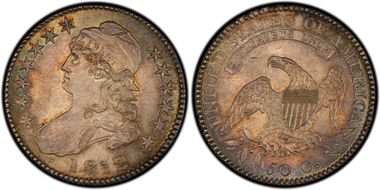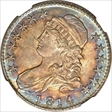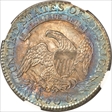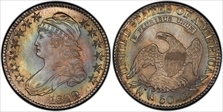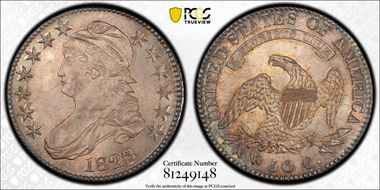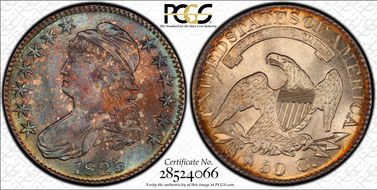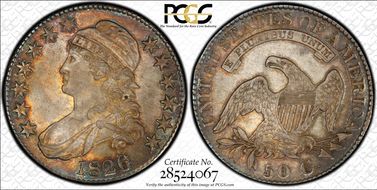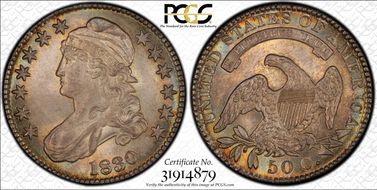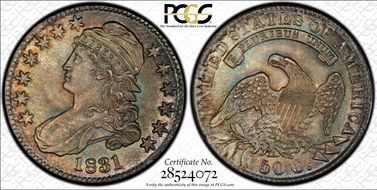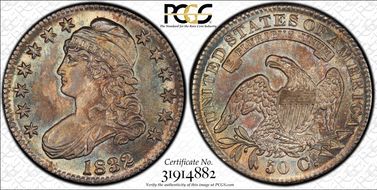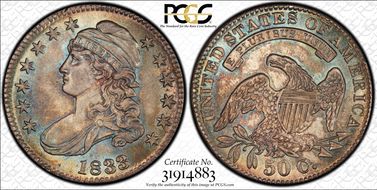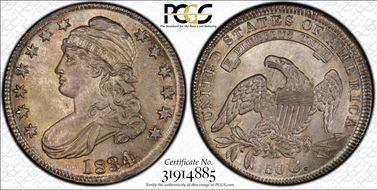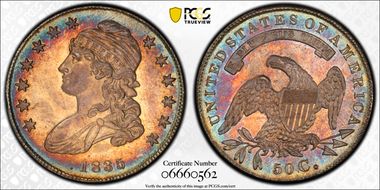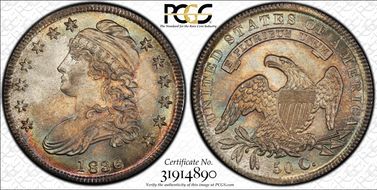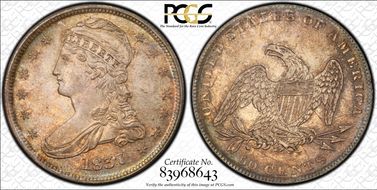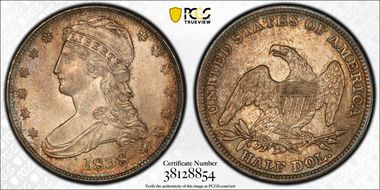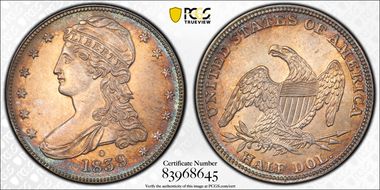The Link Early American Silver Date Set of Capped Bust Coinage 的钱币相册
LM-12 R4. Lovely colorful, blazing luster, nice strike. Obtained from the heritage Auction #1214 of the Eugene Gardener Collection on 10/27/2014, Lot 98174.
LM-12 R4. Lovely colorful, blazing luster, nice strike. Obtained from the heritage Auction #1214 of the Eugene Gardener Collection on 10/27/2014, Lot 98174.
LM-10.1 R.3. CAC. Tied Finest Known 1832 Half Dime. Per cataloger, "V-13, LM-10.1, R.3, MS67+ PCGS. CAC. Faint die clashing at the throat and ear identify the LM-10.1 variety. Star 3 is lightly repunched, and the O in OF is broadly recut at the top (the Logan-McCloskey reference describes it as a Small O over a broken Large O). Three remarriages of the LM-10 dies plus the original pairing (LM-10.1) make this variety an interesting die study. The obverse fields of the current example are prooflike, although the reverse is more frosted and negates a prooflike designation. Delightful multicolor toning covers both sides, with pink, blue, and peach-gold shades grabbing the most attention. The strike is razor-sharp. Among all Capped Bust half dimes, the 1832 is the second-most available date (behind the 1835 issue), yet in Plus-graded MS67 this coin is arguably the second-finest known." Obtained from Heritage Auction on September 17, 2015, Lot 3787.
JR-1 R3. CAC. Attractive color with central rust color surrounded by blue halo.
JR-1 R3. CAC. Attractive original surfaces surrounded by colorful album toning.
JR-1 R3. CAC. Pogue. Finest Known 1814 Small Date Dime. Striking visual eye appeal with original surfaces infused with color. Obtained from Stacks Bowers' Auction of the D. Brent Pogue Collection Part 3 on February 9, 2016.
JR-2 R.3. CAC. Finest known. Secure. The famous Office Boy variety. Silky smooth nearly perfect original surfaces with a kaleidoscope of attractive color. One of the top two large sized capped Bust Dimes ever graded by PCGS. "Apple-green and rose-red adorn the obverse of this lustrous and immaculate Superb Gem. The reverse exhibits aquamarine, violet, and autumn-gold shades. The strike is intricate aside from occasional slight incompleteness on the dentils. Among the 13 1820 die marriages, only JR-2 and JR-3 have a small 0 in the date, as they were struck from the same obverse die. JR-2 is readily distinguished from JR-3 by its blundered UNITED STATES OF AMERICA. The first S in STATES is lightly but widely repunched. The O in OF is repunched south, and the M in AMERICA is repunched west. It appears that the second S in STATES was initially entered retrograde, since an errant serif is visible at the lower right corner. The obverse is better engraved despite minor repunching on the final star. The Dime Book calls JR-2 "very popular among collectors because of the spectacular "Office Boy" recuttings. Although such die worker errors likely embarrassed the Mint in 1820, today they are viewed favorably. The lettering mistakes add a rustic charm, and also simplify attribution. The present high grade example is from a late die state with a double set of clash marks near the beak and light clash marks beneath Liberty's ear and at the tip of her upper ribbon. JR-2 is a conditionally rare variety. A search of our auction archives locates no prior appearances finer than MS65. Among those certified as JR-2 by PCGS, the present piece is finest by three grades. At NGC, the single finest as JR-2 is graded MS66. Thus, this lot may be the highest graded example of the variety. Certainly, it is difficult to believe that another may be of equal quality. From The Collection of Oliver Jung," per Heritage cataloger. Obtained from Heritage's ANA US Coins Signature Auction - Chicago #1208 on August 7, 2014, Lot 5561.
JR-2 R.3. CAC. Finest known. Secure. The famous Office Boy variety. Silky smooth nearly perfect original surfaces with a kaleidoscope of attractive color. One of the top two large sized capped Bust Dimes ever graded by PCGS. "Apple-green and rose-red adorn the obverse of this lustrous and immaculate Superb Gem. The reverse exhibits aquamarine, violet, and autumn-gold shades. The strike is intricate aside from occasional slight incompleteness on the dentils. Among the 13 1820 die marriages, only JR-2 and JR-3 have a small 0 in the date, as they were struck from the same obverse die. JR-2 is readily distinguished from JR-3 by its blundered UNITED STATES OF AMERICA. The first S in STATES is lightly but widely repunched. The O in OF is repunched south, and the M in AMERICA is repunched west. It appears that the second S in STATES was initially entered retrograde, since an errant serif is visible at the lower right corner. The obverse is better engraved despite minor repunching on the final star. The Dime Book calls JR-2 "very popular among collectors because of the spectacular "Office Boy" recuttings. Although such die worker errors likely embarrassed the Mint in 1820, today they are viewed favorably. The lettering mistakes add a rustic charm, and also simplify attribution. The present high grade example is from a late die state with a double set of clash marks near the beak and light clash marks beneath Liberty's ear and at the tip of her upper ribbon. JR-2 is a conditionally rare variety. A search of our auction archives locates no prior appearances finer than MS65. Among those certified as JR-2 by PCGS, the present piece is finest by three grades. At NGC, the single finest as JR-2 is graded MS66. Thus, this lot may be the highest graded example of the variety. Certainly, it is difficult to believe that another may be of equal quality. From The Collection of Oliver Jung," per Heritage cataloger. Obtained from Heritage's ANA US Coins Signature Auction - Chicago #1208 on August 7, 2014, Lot 5561.
JR-9 CAC. Small Date. Terrific color and eye appeal with strong luster. Tied for Finest Known 1821 Dime.
JR-1 R4. CAC. Wonderful original surfaces. Second finest known at PCGS behind a single MS66 at PCGS.
JR-2 R2. CAC. Eliasberg Gardner. Lot 98213. Per cataloger, "1825 Dime, JR-2, Pristine MS66. Ex: Eliasberg, Sole Finest at CAC. 1825 10C JR-2, R.2, MS66 PCGS. CAC. Ex: Eliasberg. This Premium Gem 1825 dime, certified in an old PCGS green-label holder with the CAC green bean and the Eliasberg pedigree, is a coin of marvelous quality. Pearl-gray central devices cede to rose-orange in the fields and finally to glints of amber, mint, and pale blue at the rims. As expected at this grade level, there are simply no distractions on the surfaces. This piece is tied for the 1825 date with three other submissions for the finest at PCGS -- but obviously the only one with the important Eliasberg pedigree, and described in that catalog as "probably the finest known." Variety: JR-2, R.2. The right side of the 2 in the date is under the lowest hair curl. The E in UNITED is above the T, and 10 C is high in the field. Population Data (3/15): As noted above, this piece is tied for the finest 1825 dime at PCGS with three others in MS66. The finest certified JR-2 at NGC is only MS62. NGC reports four MS66 1825 dimes as finest. This is the sole (and finest) MS66 1825 dime with the CAC green approval sticker. Heritage Commentary: Described in the Eliasberg catalog thusly: "Superb surfaces with satiny lustre and deep rose toning gradually giving way to blue and amber at the borders. Slight weakness among central details." The piece brought $12,100 in the Eliasberg sale -- what a bargain! Provenance: Louis E. Eliasberg, Sr.; Eliasberg Collection (Bowers and Merena, 5/1996), lot 1075; Goldbergs (6/2002), lot 2122." Obtained from Heritage Auction of the Eugene Gardner Collection on May 12, 2015, Lot 98213.
JR-2 R2. CAC. Eliasberg Gardner. Lot 98213. Per cataloger, "1825 Dime, JR-2, Pristine MS66. Ex: Eliasberg, Sole Finest at CAC. 1825 10C JR-2, R.2, MS66 PCGS. CAC. Ex: Eliasberg. This Premium Gem 1825 dime, certified in an old PCGS green-label holder with the CAC green bean and the Eliasberg pedigree, is a coin of marvelous quality. Pearl-gray central devices cede to rose-orange in the fields and finally to glints of amber, mint, and pale blue at the rims. As expected at this grade level, there are simply no distractions on the surfaces. This piece is tied for the 1825 date with three other submissions for the finest at PCGS -- but obviously the only one with the important Eliasberg pedigree, and described in that catalog as "probably the finest known." Variety: JR-2, R.2. The right side of the 2 in the date is under the lowest hair curl. The E in UNITED is above the T, and 10 C is high in the field. Population Data (3/15): As noted above, this piece is tied for the finest 1825 dime at PCGS with three others in MS66. The finest certified JR-2 at NGC is only MS62. NGC reports four MS66 1825 dimes as finest. This is the sole (and finest) MS66 1825 dime with the CAC green approval sticker. Heritage Commentary: Described in the Eliasberg catalog thusly: "Superb surfaces with satiny lustre and deep rose toning gradually giving way to blue and amber at the borders. Slight weakness among central details." The piece brought $12,100 in the Eliasberg sale -- what a bargain! Provenance: Louis E. Eliasberg, Sr.; Eliasberg Collection (Bowers and Merena, 5/1996), lot 1075; Goldbergs (6/2002), lot 2122." Obtained from Heritage Auction of the Eugene Gardner Collection on May 12, 2015, Lot 98213.
JR-1 1827/7 R2. Eliasberg, Gardner, Quint and DL Hansen pedigree. Tied Finest Known 1827 Dime. Far and away the highest graded 1827/7 dime. This is a very tough redbook variety in mint state. Original toning with moderate luster for grade. Obtained by trade with Del Roy Hansen on January 24, 2018.
JR-1 R2. CAC. Eliasberg and Gardner. Stunning original surfaces with cartwheel luster. Obtained from Heritage Auction #1214 of the Eugene Gardner Collection on October 27, 2014.
JR-2 R3. CAC. Large 10c. Tied Finest Known 1829 Dime. Per cataloger, "1829 Large 10C Dime, JR-2, MS67 Tied for Finest Known. 1829 10C Large 10C, JR-2, R.2, MS67 PCGS. CAC. Although not truly rare, JR-2 is one of the less often seen 1829 dime varieties in Mint State grades, and it is the only die pairing in the Large 10C type. Of the different denomination size types, the Small 10C is the most frequently encountered in Mint State due largely to a high number of varieties that comprise that type; the Medium 10C type closely follows, with the Large 10C variety (JR-2) rare in Uncirculated condition and the Extra Large 10C variety (JR-1) almost unobtainable at this level. This magnificent coin is not only one of the finest JR-2 dimes known, but it is also tied with just four others as the finest 1829 dime certified at PCGS, regardless of variety (4/15). Both sides show irregular splashes of deep aquamarine and violet toning over light champagne surfaces, while close study with a loupe fails to reveal any discernible abrasions. Minor striking weakness is noted on the eagle's head and talons and select hair curls, not unusual for the issue and type. An outstanding coin that will impress the most discerning numismatist.
JR-5 R1. CAC. Pogue. Finest Known Small Size Capped Bust Dime. Finest Known 1831 Dime. How exactly does this coin exist one might ask? Breathtaking color, luster with essential perfect surfaces. Flashlight luster and wow!
JR-1 R2. CAC. Light pewter toning with yellow-green highlights and solid luster. Obtained from Pinnacle Rarities on March 7, 2014
JR-1 R2. CAC. Light pewter toning with yellow-green highlights and solid luster. Obtained from Pinnacle Rarities on March 7, 2014
JR-1 R1. CAC. Gardner. Stunning coin with color, radiant luster, eye appeal and strong strike. Obtained from Heritage Auction #1214 on October 27, 2014, Lot 98235.
JR-2 R2. CAC. Tied Finest known 1836. "The Repunched Date is diagnostic for the JR-2 die marriage. A Fancy or Script 8 is punched over a Block 8. This example, as do most, shows a rim-to-rim bisecting die crack that passes through the T in LIBERTY and the hair curls to the top left of the 3. We have never before sold an 1836 dime finer than MS66 in any of our auctions. Only one other appearance 13 years ago remained unsold. This Superb Gem exhibits delicate gold toning with an olive tint, showing frosty silver luster and exceptional mint brilliance. Population: 2 in 67 (1 in 67+), 0 finer," per Heritage cataloger. Obtained from Heritage Galleries Auction #1192 on 12/5/2013, Lot 3559.
JR-2 R2. CAC. Tied Finest known 1836. "The Repunched Date is diagnostic for the JR-2 die marriage. A Fancy or Script 8 is punched over a Block 8. This example, as do most, shows a rim-to-rim bisecting die crack that passes through the T in LIBERTY and the hair curls to the top left of the 3. We have never before sold an 1836 dime finer than MS66 in any of our auctions. Only one other appearance 13 years ago remained unsold. This Superb Gem exhibits delicate gold toning with an olive tint, showing frosty silver luster and exceptional mint brilliance. Population: 2 in 67 (1 in 67+), 0 finer," per Heritage cataloger. Obtained from Heritage Galleries Auction #1192 on 12/5/2013, Lot 3559.
B-1 R.1. CAC. Tied Finest Known. "Several die states are known for the 1815 quarter, this piece being a later die state with very light clashing on each side but most notable on the reverse. Beautifully toned in shades of mauve, orange-gold, light purple and hints of green with exceptional luster and truly lovely overall eye appeal. PCGS has certified just 3 at this level with nothing graded finer and this is the only coin verified at this level by CAC. From The Clarendon Collection," per Mike Printz. "The December delivery was sent upon request of the Planter's Bank, who apparently needed the coins as a replacement for Mexican two reales coins of a similar value. An exchange of letters took place between Bailly Blanchard, cashier of the Planter's Bank, and Mint Director Robert L. Patterson. Blanchard insisted that the bank could only use quarter dollars, while Patterson wanted to send the entire amount in dimes. More than six months elapsed from the first letter requesting the coins and the date they were delivered. Several die states are known for the 1815 quarter, and this piece is a later die state with light clash marks on each side, especially visible on the reverse. It is probably one of the later January 10 coins. It is also a lovely Condition Census candidate with full silver luster beneath heavy iridescent toning, deepening to steel along the borders. Population: 3 in 66, 0 finer (11/09)," per heritage cataloger. Obtained by private treaty with Michael Printz at Harlan J Berk, Ltd. on 7/14/2013. Prior Heritage Auction 31136 on January 7, 2010, Lot 2503.
B-1 R.1. CAC. Tied Finest Known. "Several die states are known for the 1815 quarter, this piece being a later die state with very light clashing on each side but most notable on the reverse. Beautifully toned in shades of mauve, orange-gold, light purple and hints of green with exceptional luster and truly lovely overall eye appeal. PCGS has certified just 3 at this level with nothing graded finer and this is the only coin verified at this level by CAC. From The Clarendon Collection," per Mike Printz. "The December delivery was sent upon request of the Planter's Bank, who apparently needed the coins as a replacement for Mexican two reales coins of a similar value. An exchange of letters took place between Bailly Blanchard, cashier of the Planter's Bank, and Mint Director Robert L. Patterson. Blanchard insisted that the bank could only use quarter dollars, while Patterson wanted to send the entire amount in dimes. More than six months elapsed from the first letter requesting the coins and the date they were delivered. Several die states are known for the 1815 quarter, and this piece is a later die state with light clash marks on each side, especially visible on the reverse. It is probably one of the later January 10 coins. It is also a lovely Condition Census candidate with full silver luster beneath heavy iridescent toning, deepening to steel along the borders. Population: 3 in 66, 0 finer (11/09)," per heritage cataloger. Obtained by private treaty with Michael Printz at Harlan J Berk, Ltd. on 7/14/2013. Prior Heritage Auction 31136 on January 7, 2010, Lot 2503.
B-1 R5. CAC. Eliasberg. Pogue. Finest Known of the B-1 die marriage. Per cataloger, "The Finest Circulation Strike 1820 B-1 Quarter. Ex. Clapp-Eliasberg. 1820 Capped Bust Quarter. Browning-1. Rarity-5-. Large 0. Mint State-66 (PCGS). The circulation strike companion for the D. Brent Pogue Proof example. This is the finest known 1820 Browning-1 quarter in circulation strike format. A breathtaking gem, replete with the most stunning sort of satiny luster. Befitting a gem quality coin with a provenance over a century old, the rich toning breathes originality. The opalescent silver gray obverse is bordered in luxuriant tones of gold and attractive blue-green, while the reverse is more defined by its golden shades, decorated with glimpses of pastel blue and spring green. The fields are essentially pristine, with no significant contact marks, just a single microscopic hairline from beneath E on the reverse ribbon that crosses the open field under PLURI and hugs close to the top of the eagle’s beak. A more hidden hairline crosses beneath Liberty’s eye. When finding flaws amounts to seeking out individual hairlines, some idea of the surface and aesthetic quality of this piece can be inferred. The strike is without drawback anywhere from rim to centers, and the die state is crisp and early. Described in the 1997 Eliasberg catalog as “no doubt the finest known,” this coin is one of three Mint State examples recognized in the Rea-Koenings-Haroutunian census, ranked higher than an NGC MS-64 last sold in 2009 and an MS-60 from Auction ’79 that may be a duplicate for one of the AU-58s on that roster. The Browning-1 is the second rarest die marriage of the year, narrowly edged out by the Browning-5 (the finest known specimen of which is lot 1065 in the present catalog of the D. Brent Pogue Collection). PCGS has assigned the MS-66 grade to a Large 0 variety of the 1820 quarter dollar on just four occasions; at least two of those represent coins in the D. Brent Pogue Collection. PCGS# 38960. NGC ID: 23RL. Publications: Cited in Early Quarter Dollars of the United States Mint by Rory R. Rea, Dr. Glenn Peterson, Bradley S. Karoleff, and John J. Kovach, Jr., 2010. Cited in Early United States Quarters 1796-1838 by Steve M. Tompkins, 2008. Provenance: Henry and S. Hudson Chapman, by sale, January 1900; J.M. Clapp Collection; John H. Clapp, by descent; Clapp Estate; Louis E. Eliasberg, Sr. Collection, via Stack’s, 1942; Richard A. Eliasberg, by descent; Bowers and Merena’s sale of the Louis E. Eliasberg, Sr. Collection, April 1997, lot 1375." Obtained from Stacks Bowers Auction of the Brent Pogue Collection on May 19, 2015, Lot 1062.
B-5 R4+. One of the finest known for the die marriage. "This better Browning die marriage can be attributed by its curved die line beneath the bust tip. The golden-brown and dove-gray surfaces are minimally abraded, and the strike is bold except on the claws and uppermost stars. Encapsulated in a green label holder," per cataloger. Obtained from Heritage Premium Night Auction #1182 on February 7, 2013, Lot 3776.
B-5 R4+. One of the finest known for the die marriage. "This better Browning die marriage can be attributed by its curved die line beneath the bust tip. The golden-brown and dove-gray surfaces are minimally abraded, and the strike is bold except on the claws and uppermost stars. Encapsulated in a green label holder," per cataloger. Obtained from Heritage Premium Night Auction #1182 on February 7, 2013, Lot 3776.
B-1 R2. Finest Known by 3 grading points. Only 4 large Sized Capped Quarters are graded MS67 at PCGS (and none finer) Per cataloger,"Single-Finest Certified. Recently Rediscovered Example. B-1, R.2, MS67 PCGS. A small mintage of 64,080 Capped Bust quarters was accomplished in 1822, with just two die varieties known for the date. This coin represents the more available B-1 variety, easily recognized by the Square Base 2 in the denomination. The scarce B-2 variety displays a blundered 25/5/50 denomination, and employs a Curl Base 2 numeral punch. A single obverse die was used to strike the entire production run and all coins seen were struck from perfect dies. The Capped Bust quarters were first studied and attributed by die varieties in the 1870s, by Captain John W. Haseltine and John Colvin Randall. In his famous Type Table catalog from November 1881, Haseltine described the 1822 B-1 quarter in lot 1330 as: "1822; No. 1; upper left star points to the junction of the upper curl with the band on the forehead; rev., P and I in 'Pluribus' are slightly to the left of being under the centres of S and second T in 'States' very fine; scarce." The lot realized $3.40, a strong price for the time. More recent sales include the spectacular MS64 NGC example from the "Colonel" Green-Eric P. Newman Collections (Heritage, 11/2013), lot 33168, which realized $25,850. That coin was billed as the finest known business-strike 1822 B-1 quarter at the time, but this piece easily eclipses it. The present coin has been off-the-market for decades and is not included in any recent Condition Census. It is the single-finest certified example at either of the leading grading services, with no serious challenger. We believe it is the Anderson Dupont example, last sold in lot 1796 of that Stack's sale in November of 1954, but the low-quality of the image in that appearance makes plate matching problematic. Like most examples seen, this coin shows just a touch of softness on some stars and the eagle's claw, but the eagle's feathers and Liberty's hair and drapery are boldly rendered. The impeccably preserved surfaces radiate vibrant mint luster, under spectacular shades of gold, lavender, and silver-gray toning. Eye appeal is terrific. This coin is a Registry Set essential. Population: 1 in 67, 0 finer (4/15)." Obained from Heritage Long Beach Auction #1221 on June 4, 2015, Lot 3896.
B-1 R2. Finest Known by 3 grading points. Only 4 large Sized Capped Quarters are graded MS67 at PCGS (and none finer) Per cataloger,"Single-Finest Certified. Recently Rediscovered Example. B-1, R.2, MS67 PCGS. A small mintage of 64,080 Capped Bust quarters was accomplished in 1822, with just two die varieties known for the date. This coin represents the more available B-1 variety, easily recognized by the Square Base 2 in the denomination. The scarce B-2 variety displays a blundered 25/5/50 denomination, and employs a Curl Base 2 numeral punch. A single obverse die was used to strike the entire production run and all coins seen were struck from perfect dies. The Capped Bust quarters were first studied and attributed by die varieties in the 1870s, by Captain John W. Haseltine and John Colvin Randall. In his famous Type Table catalog from November 1881, Haseltine described the 1822 B-1 quarter in lot 1330 as: "1822; No. 1; upper left star points to the junction of the upper curl with the band on the forehead; rev., P and I in 'Pluribus' are slightly to the left of being under the centres of S and second T in 'States' very fine; scarce." The lot realized $3.40, a strong price for the time. More recent sales include the spectacular MS64 NGC example from the "Colonel" Green-Eric P. Newman Collections (Heritage, 11/2013), lot 33168, which realized $25,850. That coin was billed as the finest known business-strike 1822 B-1 quarter at the time, but this piece easily eclipses it. The present coin has been off-the-market for decades and is not included in any recent Condition Census. It is the single-finest certified example at either of the leading grading services, with no serious challenger. We believe it is the Anderson Dupont example, last sold in lot 1796 of that Stack's sale in November of 1954, but the low-quality of the image in that appearance makes plate matching problematic. Like most examples seen, this coin shows just a touch of softness on some stars and the eagle's claw, but the eagle's feathers and Liberty's hair and drapery are boldly rendered. The impeccably preserved surfaces radiate vibrant mint luster, under spectacular shades of gold, lavender, and silver-gray toning. Eye appeal is terrific. This coin is a Registry Set essential. Population: 1 in 67, 0 finer (4/15)." Obained from Heritage Long Beach Auction #1221 on June 4, 2015, Lot 3896.
B-1 R5+. CAC [Gold Sticker]. Gardner. The key to the Capped Bust Quarter series. Finest Known and only uncirculated circulation strike of the 31 known specimens. Per Heritage cataloger of the Gardner Collection, "Classic unsung rarity of American Numismatics. Second in the condition census. Beautiful bluish-hazel field color complements medium gray on the device high points front and back, with amber-gold accents in some protected areas. The only mentionable contact is a tick in the lower-right obverse field, just right of the date. On the reverse, a couple of small ticks appear in the field underneath UN(ITED). The strike is somewhat blunt on the peripheral stars and the lower portion of the eagle." The Eugene H. Gardner Collection II US Coins Heritage Signature Auction - New York #1214 on October 27, 2014.
B-3 R3. Newman. Finest known. Lovely original, brightly colorful, blazing luster quarter. "MS66+ NGC. B-3, R.3. Ex: "Col." E.H.R. Green. The 1825/4 B-3 represents the second use of this overdated obverse die. This is the "1825, 5 over 4" type as listed in the Guide Book, for the many collectors who assemble sets by those major varieties. Steve M. Tompkins, in Early United States Quarters 1796-1838, suggests that the obverse die was heavily lapped between its previous use with the B-2 and its next use with the B-3: "After the lapping, the curve of the 2 disappears and the remnants of the 4 [are] much more prominent. The point of the underlying 4 digit can be seen sticking out of the left side of the upright of the 5, as well as more of the crossbar can be seen inside the loop of the 5. This has caused the B-3 die marriage to be called a 5 over 4. The remnant of either the 2 or the upright of the 4 is visible from the upper curve of the 5 to the flag of the 5 on all stages and in both die marriages, and the end of the crossbar from the 4 is visible sticking out of the right outside curve of the 5." The 1825/4 B-3 die marriage was created by using the relapped B-2 obverse die and mating it with a new reverse die. On the B-3 reverse, the scroll begins between the E and D in UNITED and ends under the right foot of the first A in AMERICA. The I in PLURIBUS is under the space between the A and T in STATES. The arrow feather is almost over the right tip of the 2 in 25C and the olive stem is over the right side of the C. This coin was stuck from the perfect state of the dies. This is the plate coin in the Rea-Peterson-Karoleff-Kovach Early Quarter Dollars of the United States Mint. This piece is also the Browning plate coin, hailing before the Green acquisition from the collection of early quarters pioneer-researcher Ard W. Browning. The Newman Collection coin, MS66+ by NGC, is the finest graded for both the die marriage and the date (10/13). This is another spectacularly toned early quarter. The obverse is attractively toned with blue on the outside surrounding lustrous gray and gold centers. The reverse is mostly a medium silver-gray, with blue and gold toning around the peripheral areas. Ex: U.S. Coin Co. (1913); Ard W. Browning; "Colonel" E.H.R. Green; Green Estate; Partnership of Eric P. Newman / B.G. Johnson d.b.a. St. Louis Stamp & Coin Co.; Eric P. Newman @ $10.00; Eric P. Newman Numismatic Education Society," per Heritage Newman catalog. Sold prior in the Heritage Eric P. Newman Auction on November 15, 2013, Lot 33346. Crossed from an NGC MS66+ holder. Private treaty with Pinnacle Rarities on March 7, 2014.
B-3 R3. Newman. Finest known. Lovely original, brightly colorful, blazing luster quarter. "MS66+ NGC. B-3, R.3. Ex: "Col." E.H.R. Green. The 1825/4 B-3 represents the second use of this overdated obverse die. This is the "1825, 5 over 4" type as listed in the Guide Book, for the many collectors who assemble sets by those major varieties. Steve M. Tompkins, in Early United States Quarters 1796-1838, suggests that the obverse die was heavily lapped between its previous use with the B-2 and its next use with the B-3: "After the lapping, the curve of the 2 disappears and the remnants of the 4 [are] much more prominent. The point of the underlying 4 digit can be seen sticking out of the left side of the upright of the 5, as well as more of the crossbar can be seen inside the loop of the 5. This has caused the B-3 die marriage to be called a 5 over 4. The remnant of either the 2 or the upright of the 4 is visible from the upper curve of the 5 to the flag of the 5 on all stages and in both die marriages, and the end of the crossbar from the 4 is visible sticking out of the right outside curve of the 5." The 1825/4 B-3 die marriage was created by using the relapped B-2 obverse die and mating it with a new reverse die. On the B-3 reverse, the scroll begins between the E and D in UNITED and ends under the right foot of the first A in AMERICA. The I in PLURIBUS is under the space between the A and T in STATES. The arrow feather is almost over the right tip of the 2 in 25C and the olive stem is over the right side of the C. This coin was stuck from the perfect state of the dies. This is the plate coin in the Rea-Peterson-Karoleff-Kovach Early Quarter Dollars of the United States Mint. This piece is also the Browning plate coin, hailing before the Green acquisition from the collection of early quarters pioneer-researcher Ard W. Browning. The Newman Collection coin, MS66+ by NGC, is the finest graded for both the die marriage and the date (10/13). This is another spectacularly toned early quarter. The obverse is attractively toned with blue on the outside surrounding lustrous gray and gold centers. The reverse is mostly a medium silver-gray, with blue and gold toning around the peripheral areas. Ex: U.S. Coin Co. (1913); Ard W. Browning; "Colonel" E.H.R. Green; Green Estate; Partnership of Eric P. Newman / B.G. Johnson d.b.a. St. Louis Stamp & Coin Co.; Eric P. Newman @ $10.00; Eric P. Newman Numismatic Education Society," per Heritage Newman catalog. Sold prior in the Heritage Eric P. Newman Auction on November 15, 2013, Lot 33346. Crossed from an NGC MS66+ holder. Private treaty with Pinnacle Rarities on March 7, 2014.
B-4 R3. CAC. Per cataloger, ""Incredible Gem 1828 Bust Quarter. Boldly Prooflike. Finest Graded by PCGS. 1828 Capped Bust Quarter. B-4. Rarity-3. MS-66+ (PCGS). CAC. The portrait of Miss Liberty is boldly rendered and displays delicate violet-gold iridescence. The surrounding reflective fields display amber and indigo iridescence radiating out toward the peripheries. The reflectivity is even more pronounced on the reverse, where the field contrasts markedly with a fully impressed, razor sharp eagle. Vibrant tangerine tones at the center of the reverse cool to teal at the borders. Virtually pristine and thoroughly appealing. This coin ranks as the single finest 1828 quarter of any die variety known to PCGS. We had the pleasure of offering this coin in our (Bowers and Ruddy) February 1976 Dr. D.C. Montgomery, Jr. Collection sale. As that time we described this piece as: ""1828 quarter dollar. Perfect reverse die. Purchased as a superb Proof, this coin possesses 99% of the characteristics of a later (i.e., Liberty seated) Proof, including prooflike surface within the shield stripes. It was undoubtedly struck as a presentation piece, so perfect are its fields and so sharp is its strike. ""If an equal or finer 1828 quarter dollar exists, we haven't seen it. Actually, it is doubtful if a finer one could exist, even in theory. A superb coin for the connoisseur!"" In the numismatic market of the 21st century, the science of positively identifying early (read: pre-1858) United States Mint Proof and specimen coins has become more exact, and PCGS has determined the present example to be a circulation strike. Proofs are known from the 1828 B-4 quarter dies, however, with the online version of the PCGS Population Report accounting for six to eight examples. That estimate squares nicely with the census of seven Proofs listed in the 2010 book Early Quarter Dollars of the United States Mint: 1796-1838 by Rory R. Rea, et al. The existence of Proofs for this variety, coupled with the exceptional strike and prooflike finish of this coin, suggest that it was one of the very first circulation strikes produced after these dies were used to strike one or more of the Proofs. However PCGS is in full concurrence with our earlier (and also current) assessment of this coin as they have confirmed it as the finest 1828 quarter ever to pass through their hands. One of the leading highlights in the Kaselitz Collection -- which is saying quite a lot given the multitude of significant offerings herein. This Gem is sure to see spirited bidding among leading numismatists. Pedigree: Ex our (Bowers and Ruddy's) Dr. D.C. Montgomery, Jr. Collection sale, February 1976, lot 1271.PCGS Population (all die varieties of the issue): just 1; 0 finer." Obtained from Stacks Bowers Auction of the Douglas Kaselitz Collection on July 17, 2015, Lot 5142.
B-1 R2. Pogue. Finest Known 1833 quarter. Blazing luster and original pristine surfaces. Per Stacks cataloger, "A die marriage of 1833 struck both before and after quarters dated 1832. This gem is a visual delight, showing some of the most magnificent toning we have seen on a coin of this design type or any of its era. Its shading and texture is most reminiscent of the toning sometimes seen on superb gems from the World War I era: dappled in gold and dark amber around the obverse periphery, blended periwinkle and violet at the center of that side, while the reverse frames the lavender center with bright pastel blue. Brisk cartwheel luster spins around both sides. The eye appeal is exceptional, and the surfaces are pristine. The strike shows some select areas of softness, particularly at some star centers and on the lowest curl, but this is not unusual for the issue. Abundant spalling, or chipping of the die surface, is present on both the obverse and reverse die. The progress of this spalling allows this coin to be placed in a striking sequence after 1833 Browning-2. Significant spalling may be seen between the date and the bust truncation, at the tip of the bust, between stars 5 and 6 into the field, above star 7, behind cap above star 8, outside the area between stars 10 and 11, and right of the date. On the reverse, the die shows spalling at E of UNITED, between STA of STATES and the beak, between the second and third arrowheads, around the denomination, and some smaller areas near the denticles. The dies have also clashed, with a faint clash visible around the central reverse and a heavy clash of the shield gules around Liberty’s ear. Just two die marriages of quarters were dated 1833, though not all quarters struck in 1833 bore that date. Through examination of the die states, students of the series have found that this die variety was made before a portion of the coins from the die marriage known as 1832 Browning-2. This marriage used a reverse die that was used twice in 1831 and once in 1832, but some of those 1832 coins were actually struck in 1833. Such studies seem confusing to the uninitiated, but fascinate specialists, who avidly follow the appearance of each microscopic die flaw that indicates a further degradation of the die surface and enables a continuum such as this to be logically constructed. The die state of this coin is among the latest known, placing its production after all the coins dated 1832 and nearly all the coins dated 1833. Adding further interest, this coin is the single finest example seen by PCGS. PCGS# 38989. NGC ID: 23RY. Provenance: Lawrence R. Stack Type Set, by sale." Obtained from Stacks Bowers Auction of Brent Pogue Collection on May 19, 2015, Lot 1085.
B-5 R.2. CAC. Gardner. Tied second finest at PCGS. Per cataloger, "Condition census for the date and variety. This stellar Gem B-5 1835 quarter is toned medium-gray in the centers while combining blue peripheral accents and hints of rose-gold in the fields. The surface quality is outstanding, as expected for the grade. This piece is identifiable by a pair of minute nicks in the field before Liberty's chin and another tick on the neck. The strike is sharp on all of Liberty's curls and each star save for star 7, which lacks the central radial lines." Sold previously in the Heritage Auction #1214 of the Eugene Gardner Collection on October 27, 2014, Lot 98351. Obtained by private treaty with legend Numismatics on October 31, 2014.
B-5 R.2. CAC. Gardner. Tied second finest at PCGS. Per cataloger, "Condition census for the date and variety. This stellar Gem B-5 1835 quarter is toned medium-gray in the centers while combining blue peripheral accents and hints of rose-gold in the fields. The surface quality is outstanding, as expected for the grade. This piece is identifiable by a pair of minute nicks in the field before Liberty's chin and another tick on the neck. The strike is sharp on all of Liberty's curls and each star save for star 7, which lacks the central radial lines." Sold previously in the Heritage Auction #1214 of the Eugene Gardner Collection on October 27, 2014, Lot 98351. Obtained by private treaty with legend Numismatics on October 31, 2014.
B-2 R1. CAC. Gardner. Exquisite beauty with color, dazzling luster and great eye appeal. private treaty with Legend Numismatics on October 22, 2014. l
B-1 R1. Tied Finest known. Lovely original surfaces with underlying luster.
O-108 R3. Newman. CAC. Finest Known 1810 Half Dollar. Fantastic creamy orginal surfaces with stunning eye appeal for an 1810 half dollar. Crossed from NGC MS66.
O-103 R1. CAC. Finest Known 1814 half dollar by grade. Actually, tied for another coin graded MS66+ IMHO. Per Heritage cataloger, "marvelous preservation and toning. This available die pairing is recognized on the obverse by star 7, which has one point at the juncture of the upper and lower curls on Liberty's forehead. Most examples, including the present one, show die clashing in obverse fields. Multiple vertical die lines run down to the rim from below the forward portion of the bust. On the reverse, a heavy defect ridge or die line runs from the scroll beneath the initial E, downward to the center of the left (facing) wing. The mint luster, thick and frosted, displays abundantly evident through the toning. The centers are silver-gray, with a light accent of rose surrounded by cobalt-blue at the extreme margins on each side. As is the case for many 1814 half dollars, this piece is quite sharply struck (although, as the Overton reference points out, that sharp strike came at the expense of sharp die clashing when there was no intervening planchet). As demanded at this incredible grade level, there are no visible abrasions or adjustment marks, save for the aforementioned die clashing in the fields." Crossed from NGC MS68* to PCGS in September of 2016. Obtained from Heritage US Coins Signature Auction- Long Beach #1171 on May 31, 2012, Lot 3777.
O-103 R1. CAC. Finest Known 1814 half dollar by grade. Actually, tied for another coin graded MS66+ IMHO. Per Heritage cataloger, "marvelous preservation and toning. This available die pairing is recognized on the obverse by star 7, which has one point at the juncture of the upper and lower curls on Liberty's forehead. Most examples, including the present one, show die clashing in obverse fields. Multiple vertical die lines run down to the rim from below the forward portion of the bust. On the reverse, a heavy defect ridge or die line runs from the scroll beneath the initial E, downward to the center of the left (facing) wing. The mint luster, thick and frosted, displays abundantly evident through the toning. The centers are silver-gray, with a light accent of rose surrounded by cobalt-blue at the extreme margins on each side. As is the case for many 1814 half dollars, this piece is quite sharply struck (although, as the Overton reference points out, that sharp strike came at the expense of sharp die clashing when there was no intervening planchet). As demanded at this incredible grade level, there are no visible abrasions or adjustment marks, save for the aforementioned die clashing in the fields." Crossed from NGC MS68* to PCGS in September of 2016. Obtained from Heritage US Coins Signature Auction- Long Beach #1171 on May 31, 2012, Lot 3777.
O.101 R2. Finest Known of this key date. A+ Eye Appeal. Per Heritage cataloger, "Ex: Kaufman. Numismatists and collectors who seek a complete date collection must acquire an 1815 half dollar. Similarly, die variety specialists require an example, and those who seek die states must have two different pieces. Many design type collectors have the formation of a complete type set of key-date coins as their goal, and the 1815 half dollar is the best candidate. Finally, a growing trend is the acquisition of "trophy coins," those pieces that combine rarity, quality, and exceptional aesthetic appeal, and this Premium Gem 1815 half dollar combines all of those factors. Demand for a specimen such as this rarity has never been higher. The finest 1815 half dollars are the present early die state piece and the Eliasberg Gem late die state specimen. Following these two pieces, we find approximately 20 other auction records of MS63 and MS64 coins over the last 20 years. However, we have no hesitation calling the present piece the finest known 1815 half dollar. It has bold central details with an almost medallic appearance, the stars at the left border are strong while those to the right are weak. Both sides have soft, frosty silver luster with grayish-gold patina, surrounded by blue-green, gold, rose, and iridescent toning. The surfaces are well-preserved, with no evidence of mishandling. This Premium Gem is one of the landmark opportunities in the current sale, and once sold, may not appear on the market for many years. Ex: The Chicago Sale (RARCOA and David W. Akers, Inc., 8/1991), lot 523; Central States Signature (Heritage, 4-5/2009), Lot 2415 per Heritage cataloger. Obtained from Heritage Platinum Auction on August 8, 2012, Lot 5143. Crossed from NGC MS66+ to PCGS MS66.
O-110a Finest Known 1817 Half Dollar. One of the most visually stunning capped Bust Halves in existence according to a survey of those who love the series. Must be seen to be appreciated.
O-106. CAC. R3. Finest Known 1822 Half Dollar. Blazing cartwheel luster and color with pristine surfaces. Visually stunning eye appeal. Obtained by private treaty from Numismatic Americana on August 15, 2018.
O-106. CAC. R3. Finest Known 1822 Half Dollar. Blazing cartwheel luster and color with pristine surfaces. Visually stunning eye appeal. Obtained by private treaty from Numismatic Americana on August 15, 2018.
O-107 R1. Eliasberg. Tied Finest Known 1823 Half Dollar at PCGS and Finest Known at NGC. This coin was the only coin that either NGC or PCGS graded MS67. Lovely satin surfaces that are exceptionally clean. Strong sparkling cartwheel luster. From Louis E. Eliasberg, Sr. Estate (Bowers and Merena, April 1997, Lot 1795.
O.104 R4+. "This half dollar is so much more than a Premium Gem. It has amazing eye appeal with green, rose, and iridescent toning on the obverse, and light gold on the reverse. The strike is bold and well-centered, and the surfaces are highly lustrous and pristine. An amazing example, but also an extremely important offering," per Heritage cataloger. Obtained from Heritage Galleries' Auction Auction #1175 on October 12, 2012.
O-103 R1. CAC. Eliasberg. Pogue. Second Finest 1830 Small O Half Dollar. Wonderful original grey dirt surfaces imbued with color.
O-107 R3. CAC. Second Finest Known 1831 Capped Half Dollar. Visually stunning, very flashy, wow colors and pizazz! Obtained from Harry Laibstain Rare Coins by private treaty on January 10, 2013.
O-109 R2. CAC. Eliasberg, Jung. Finest Known 1835 Capped Bust Half Dollar. Stellar eye appeal with proof life surfaces and blue and orange concentric toning. Eliasberg, Jung, Kaufman. Per Heritage cataloger, "Possible Presentation Strike. Ex: Eliasberg/Kaufman. O-109, R.2. Both dies are perfect on this remarkable piece. The obverse has star 7 minutely recut, and the flag of the 5 is long and straight with only a tiny upward curve at its tip. In the Eliasberg catalog, this beauty was presented as "possibly a presentation striking" and "far and away the finest known." Original 1835 proof half dollars are extremely rare, as most proofs of this date are technically restrikes with the edge lettering crushed. The restrikes were made a short time later, perhaps in 1836. This Superb Gem has incredible surfaces with fully prooflike fields, save for tiny areas of mint frost in the left obverse field. While clearly not a proof, this beautiful example was carefully produced, and is an attractive representative of the 1835 coinage issues that approached the end of an era, before steam power was introduced late the next year. Easily the finest known example, this piece is one of half a dozen MS63 or finer examples of the variety known to us. Both sides have an amazing strike with all details boldly defined, a few stars at the left being the only exception. The obverse has brilliant gold toning with incredible rose, lilac, and blue peripheries. The reverse is deeper in appearance but similarly toned. Census: 1 in 67 ★. Ex: Louis E. Eliasberg, Sr.; Eliasberg Estate (Bowers and Merena, 4/1997), lot 1899. From the Joseph C. Thomas Collection." Obtained from the Oliver Jung "The Type Set" by private treaty with Joe O'Connor on 9/1/2019.
GR-18 CAC. R.1 Lovely original tan surfaces with outstanding eye appeal. Among the finest known of all 1837 halves, and very competitive in coins in MS67 holders (one of which I turned down for this current one). Per cataloger, "Beautiful 1837 Reeded Edge Half Dollar. Condition Census. 1837 Capped Bust Half Dollar. Reeded Edge. 50 CENTS. GR-18. Rarity-1. MS-66 (PCGS). CAC. This is a stunning example of a short-lived, design type in the Capped Bust half dollar series. Soft sandy-silver patina is enhanced with wisps of iridescent olive-russet and champagne-apricot highlights that are largely confined to the peripheries. Intense satin luster is seen throughout and the striking detail is sharp to full. This is easily one of the most carefully preserved, visually appealing examples of the Capped Bust, Reeded Edge, 50 CENTS half dollar that we have ever offered. It is sure to see spirited bidding among advanced specialists and Gem type collectors. This short-lived type, produced only in 1836 and 1837, came about through the introduction of steam coinage to the United States Mint. The first working dies for the Reeded Edge Capped Bust half dollar were completed by Christian Gobrecht during the autumn of 1836. The type is superficially similar to that of its Lettered Edge predecessor, although Liberty's portrait and the eagle have a more refined look, the scroll on which the Latin motto E PLURIBUS UNUM was engraved in the upper reverse field is gone, and the diameter is smaller and more uniform within a beaded border. The final-listed refinement, in particular, was meant to accommodate the close collar, a new innovation to the United States made possible by the introduction of the steam press. The close collar allowed the Mint to produce half dollars not only of a uniform diameter, but also with a reeded edge for the first time. A final innovation of the revolutionary Reeded Edge half dollar is a revised weight standard of 13.36 grams, as stipulated by the Act of January 18, 1837. Gobrecht's initial Reeded Edge half dollar design has the denomination expressed as 50 CENTS along the lower reverse border. This was changed in 1838 to read HALF DOL., presumably for uniformity with the contemporary quarter and silver dollar. Given the rarity and key date status of the 1836 Reeded Edge, the 1837 is the only realistic type candidate of the 50 CENTS design for most collectors. Mint State examples, however, are scarce in an absolute sense and rare relative to the strong demand for them among collectors building high grade type sets. In the finest Mint State grades, as here, the 1837 is very rare by any standard. Solidly in the Condition Census for both the issue and the type. This handsomely toned, expertly preserved Gem represents an important find for the connoisseur. Exquisite! PCGS Population (all die marriages of the issue): only 5; with a lone MS-67 finer." Obtained from Stacks Bowers Auction of the Douglas Kaselitz Collection on July 2015
GR-11 R1. CAC. Eliasberg. Finest Known 1838 Half Dollar. Per Heritage cataloger, "Lot 5149. Wow! "The Mint introduced steam-powered coin presses in 1836 and used a close collar on the half dollar denomination for the first time, as well. These innovations made the Reeded Edge design possible, and large numbers of high-quality coins could be produced to meet the economic needs of the time. The reverse design was changed in 1838, with the denomination expressed as HALF DOL. instead of 50 CENTS, and the Capped Bust obverse was replaced by Gobrecht's Seated Liberty in 1840. As the first issue of the short-lived HALF DOL. design, the 1838 Reeded Edge half dollar is especially important to type collectors. The present coin is the finest known example of the date, with no serious challenger. This coin is the single finest certified at NGC, while PCGS has graded no examples finer than MS66 (11/11). It occupies the number 1 spot in Stephen J. Herrman's Condition Census and claims a pedigree of illustrious owners back to the 19th century. This coin traces its history to the fabled Eliasberg Collection, and before that to the famous father-and-son collecting team of John M. and John H. Clapp, and finally to H.P. Smith, who served as a sort of dean of respected coin dealers in the late 19th century. Eliasberg was the only collector to ever complete a full collection of U.S. federal coins by date, mintmark, and major design type. He was also justly famous for the quality of the coins in his collection, as he would accept only the finest available specimens. The present coin is a marvelous Superb Gem, with sharply detailed design elements throughout. The eagle's claws are complete and fine definition shows on all of Liberty's curls. The virtually pristine surfaces are blanketed in attractive shades of russet-gold and gunmetal-blue patina, with satiny mint luster on both sides. This magnificent coin should find a home in the finest collection of Reeded Edge half dollars. The present coin is a marvelous Superb Gem, with sharply detailed design elements throughout. The eagle's claws are complete and fine definition shows on all of Liberty's curls. The virtually pristine surfaces are blanketed in attractive shades of russet-gold and gunmetal-blue patina, with satiny mint luster on both sides. This magnificent coin should find a home in the finest collection of Reeded Edge half dollars." Ex: Harlan Page Smith Collection (S.H. & H. Chapman, 5/1906), lot 667; John M. Clapp; John H. Clapp; Clapp Estate to Louis Eliasberg in 1942, via Stack's; Louis E. Eliasberg, Sr. Collection (Bowers and Merena, 4/1997), lot 1910; Pre-Long Beach Elite Coin Auction (Superior, 5/2006), lot 4233; Johnson-Blue Collection (Stack's, 8/2010), lot 502; FUN (Heritage, 1/2012), lot 3233". Obtained at Heritage Platinum Night Auction #1173 on August 3, 2012. Crossed from NGC MS67 [686283-002} to PCGS MS66+ on 6/23/2017.
GR-5 CAC. R.2 Finest Known 1839 Half Dollar. Terrific eye appeal and originality. Obtained from Stacks Bowers Auction of the D. Brent Pogue Collection on may 24, 2016, Lot 4009.
GR-1 R1. CAC. Tied for Finest Known? Ex: Gene Gardner. Terrific eye appeal with central orange with peripheral matching blue toning on the obverse and reverse. Impressively clean surfaces for the grade with essentially no visible marks. More than 90% of 1839-O halves are of the GR-1 variety. As an aside, there are two unique die marraiges currently of Reeded Edge Halves and they are both 1839-O, GR-2 and GR-3. Obtained from the Heritage Auction of the Eugene Gardner Collection on June 23, 2014.





















